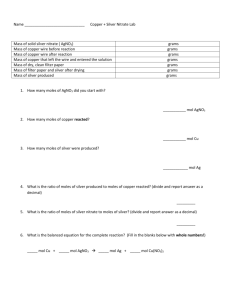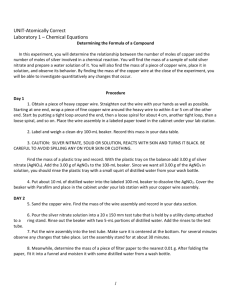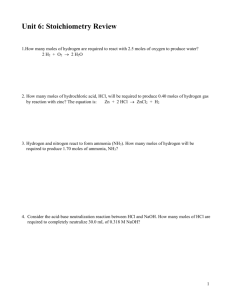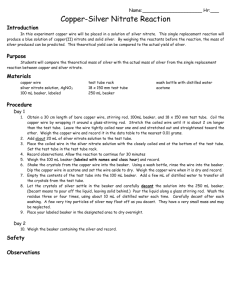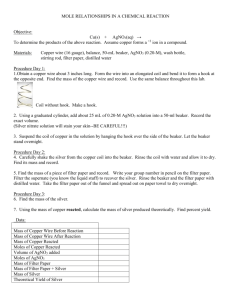Introduction
advertisement
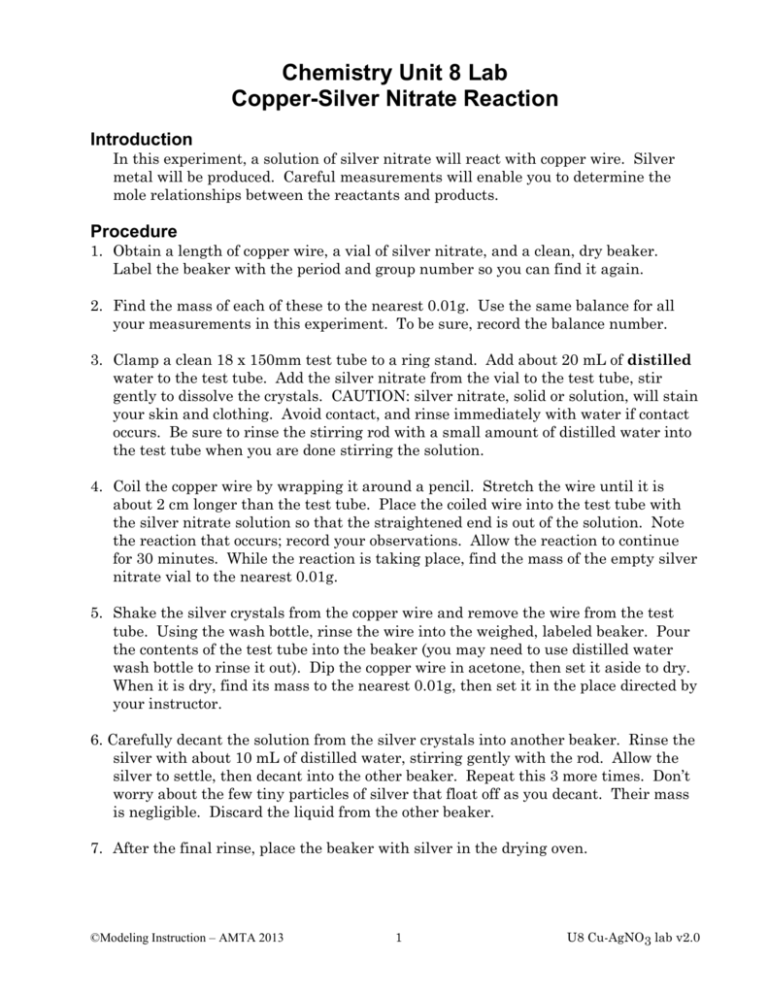
Chemistry Unit 8 Lab Copper-Silver Nitrate Reaction Introduction In this experiment, a solution of silver nitrate will react with copper wire. Silver metal will be produced. Careful measurements will enable you to determine the mole relationships between the reactants and products. Procedure 1. Obtain a length of copper wire, a vial of silver nitrate, and a clean, dry beaker. Label the beaker with the period and group number so you can find it again. 2. Find the mass of each of these to the nearest 0.01g. Use the same balance for all your measurements in this experiment. To be sure, record the balance number. 3. Clamp a clean 18 x 150mm test tube to a ring stand. Add about 20 mL of distilled water to the test tube. Add the silver nitrate from the vial to the test tube, stir gently to dissolve the crystals. CAUTION: silver nitrate, solid or solution, will stain your skin and clothing. Avoid contact, and rinse immediately with water if contact occurs. Be sure to rinse the stirring rod with a small amount of distilled water into the test tube when you are done stirring the solution. 4. Coil the copper wire by wrapping it around a pencil. Stretch the wire until it is about 2 cm longer than the test tube. Place the coiled wire into the test tube with the silver nitrate solution so that the straightened end is out of the solution. Note the reaction that occurs; record your observations. Allow the reaction to continue for 30 minutes. While the reaction is taking place, find the mass of the empty silver nitrate vial to the nearest 0.01g. 5. Shake the silver crystals from the copper wire and remove the wire from the test tube. Using the wash bottle, rinse the wire into the weighed, labeled beaker. Pour the contents of the test tube into the beaker (you may need to use distilled water wash bottle to rinse it out). Dip the copper wire in acetone, then set it aside to dry. When it is dry, find its mass to the nearest 0.01g, then set it in the place directed by your instructor. 6. Carefully decant the solution from the silver crystals into another beaker. Rinse the silver with about 10 mL of distilled water, stirring gently with the rod. Allow the silver to settle, then decant into the other beaker. Repeat this 3 more times. Don’t worry about the few tiny particles of silver that float off as you decant. Their mass is negligible. Discard the liquid from the other beaker. 7. After the final rinse, place the beaker with silver in the drying oven. ©Modeling Instruction – AMTA 2013 1 U8 Cu-AgNO3 lab v2.0 8. When the silver is dry, find the mass of the beaker and silver to the nearest 0.01g. Then, place the beaker in the fume hood, and pour 5.0 mL of 6M HNO3 (nitric acid) into the beaker. The nitric acid reacts with the silver producing the reddish-brown NO2 gas (quite noxious, do not smell it) and turning the silver back into silver nitrate, AgNO3. This will be used in the next experiment. Data balance # mass of beaker g mass of vial + AgNO3 g mass of Cu wire before g mass of empty vial g mass of Cu wire after g mass of beaker + dry Ag g Calculations 1. Determine the mass of copper that reacted during the experiment. Convert this to moles of Cu. 2. Determine the mass of silver produced during the experiment. Convert this to moles of Ag. 3. Determine the value of the ratio: moles Ag . Be sure to use the appropriate SF. molesCu 4. Determine the mass and then the number of moles of AgNO3 used in the lab. 5. Determine the value of the ratio: moles Ag . Be sure to use the appropriate SF. moles AgNO3 ©Modeling Instruction – AMTA 2013 2 U8 Cu-AgNO3 lab v2.0 Conclusion 1. Because of our deep and abiding belief that atoms react in simple integer ratios, moles Ag produced what do you suppose is the actual ratio of ? molesCu consumed You should use class results to help you decide the correct value. From your answer, write the balanced equation for the reaction between copper and silver nitrate. 2. Make a BCA table for this chemical reaction. Enter the value of moles AgNO3 in the before line and xs for moles of Cu. In the change line, enter the moles of Cu reacted. Now, use the moles of Cu to complete the table. Next, determine the theoretical yield of mass of Ag. From your actual mass of Ag and the theoretical yield, determine the % yield. moles Ag produced is greater than the accepted value, then either the molesCu consumed moles of Ag is too high, or the moles of Cu is too low. If your ratio is lower than the accepted value, then either the moles of Ag is too low, or the moles of Cu is too high. Use the % yield to help you decide whether the problem is due to the value you have obtained for the moles of silver. List at least one specific experimental error that could account for ratio being too high or too low. 3. If your ratio 4. It is possible that your value of the ratio moles Ag is less than 1.00 even if your moles AgNO3 moles Ag produced is acceptable. Assuming that you did not lose silver during molesCu consumed decanting, what could account for a ratio being smaller than one? ratio ©Modeling Instruction – AMTA 2013 3 U8 Cu-AgNO3 lab v2.0
